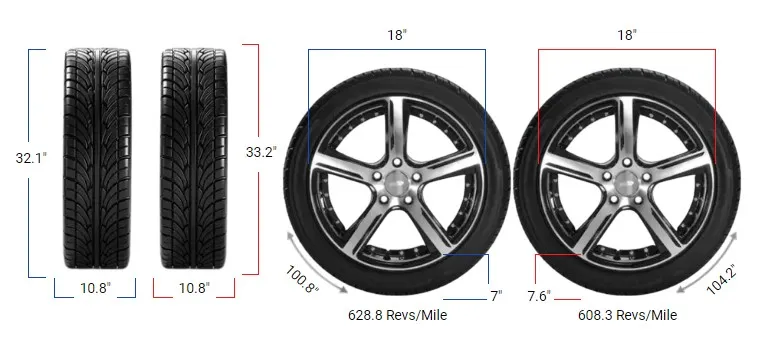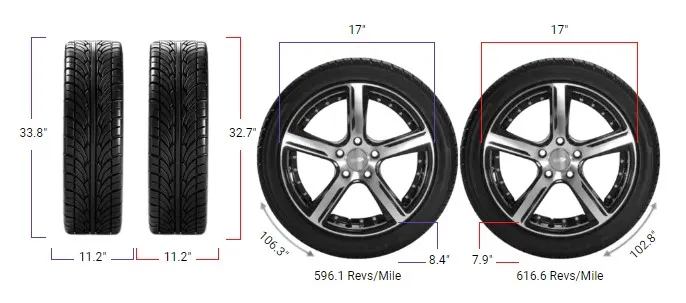Tire Size 255/70r17 vs 265/70r17

Switching from 255/70R17 to 265/70R17 can bring several differences to your driving experience. Let’s explore the key factors involved in making this switch, including fitment, performance, and more.
- Increased ground clearance improves off-road capability.
- Wider tires provide enhanced traction on rough surfaces.
- Ride comfort is improved due to a larger sidewall height.
- Gas mileage may slightly decrease due to increased rolling resistance.
- Speedometer readings may be slightly less accurate.
- The vehicle gains a more aggressive, aesthetic look.
- Better load distribution may contribute to increased tire durability.

Fitment Guide
The replacement tires must be within plus or minus 3% of the original tire’s overall diameter. For the 255/70R17 to 265/70R17 switch, the difference in diameter is 1.8%, which is within the acceptable range.
This means the switch is possible without major modifications, though some minor adjustments might still be necessary to prevent issues like rubbing or clearance problems.
On-Road Impact
Switching to 265/70R17 from 255/70R17 can have noticeable effects on your on-road driving experience. Below, we discuss specific aspects such as gas mileage, ride comfort, speedometer accuracy, and more.
Gas Mileage
With a wider tread and larger diameter, the 265/70R17 tires may slightly affect your vehicle’s gas mileage.
The increased contact area with the road causes more rolling resistance, leading to potentially lower fuel efficiency. However, this difference is often marginal and may be negligible for most daily driving scenarios.
Ride Comfort
The 265/70R17 tire’s larger sidewall height of 7.3 inches contributes to better ride comfort, particularly when driving over bumps and potholes.
The additional cushioning helps absorb road imperfections, resulting in a smoother ride compared to 255/70R17. This enhanced comfort is particularly noticeable on highways and city roads with uneven surfaces.

Speedometer Accuracy
The difference in overall tire diameter can impact speedometer accuracy. With 265/70R17, the speedometer will read slightly slower than your actual speed.
For instance, when the speedometer reads 20 mph, the vehicle’s actual speed is approximately 20.35 mph. While this difference may seem small, it’s important to be aware of it to avoid speeding inadvertently.
Durability & Wear
The wider footprint of the 265/70R17 tires can also affect durability and wear. Typically, wider tires distribute the load over a larger area, which can reduce wear in some cases.
However, this is also influenced by driving habits and alignment, so regular tire maintenance is key to maximizing lifespan.
Off-Road Impact
Switching to 265/70R17 offers several advantages for off-road enthusiasts. Let’s dive into how the change affects ground clearance, traction, and vehicle capability.

Ground Clearance
With a larger diameter, the 265/70R17 tire provides an increase in ground clearance. This difference, though just 0.55 inches, can make a noticeable improvement when tackling off-road terrain.
Extra ground clearance helps prevent damage from rocks or uneven surfaces, making it a favorable option for off-road adventures.
Traction
The wider tread of 265/70R17 enhances traction, particularly on loose surfaces like dirt, sand, or gravel.
More contact area means better grip, which is advantageous for maintaining stability when off-roading. This added traction can significantly improve your vehicle’s ability to navigate challenging terrains.
Vehicle Capability
The switch to 265/70R17 tires can improve your vehicle’s overall capability in off-road conditions. With better traction and increased ground clearance, your vehicle becomes more adept at handling steep inclines, declines, and rough paths.
The trade-off is that the increased tire width can lead to more resistance, which may slightly impact acceleration and maneuverability, particularly in tight spots.
Aesthetic Look
A noticeable advantage of switching to 265/70R17 is the improved aesthetic look of your vehicle. The wider tires give a more aggressive and robust appearance, which is often preferred by truck and SUV owners.
This aesthetic upgrade can enhance the overall presence of your vehicle, making it look more rugged and capable.
255/70r17 vs 265/70r17
This table compares the key features of the 255/70R17 and 265/70R17 tire sizes.
| Feature | 255/70R17 | 265/70R17 | Difference |
|---|---|---|---|
| Diameter inches (mm) | 31.06 (788.8) | 31.61 (802.8) | 0.55 (14) +1.8% |
| Width inches (mm) | 10.04 (255) | 10.43 (265) | 0.39 (10) +3.9% |
| Circumference inches (mm) | 97.56 (2478.09) | 99.29 (2522.07) | 1.73 (43.98) +1.8% |
| Sidewall Height inches (mm) | 7.03 (178.5) | 7.30 (185.5) | 0.28 (7) +3.9% |
| Revolutions per mile (km) | 649.43 (403.54) | 638.10 (396.50) | -11.33 (-7.04) -1.7% |
| Speedo Reading | 20 mph | 20.35 mph | +0.35 mph |
Difference Between 255/70R17 and 265/70R17
The 265/70R17 tire is slightly wider and taller than the 255/70R17, offering increased ground clearance and better traction.
Can I Use 265/70R17 Instead of 255/70R17?
Yes, you can use 265/70R17 instead of 255/70R17, but be aware of a slight increase in width and height, affecting handling and speedometer accuracy.
How Much Taller Is a 265/70R17 Tire Than a 255/70R17?
A 265/70R17 tire is approximately 0.55 inches taller than a 255/70R17 tire, increasing overall height and potentially affecting clearance.
How Much Wider is a 265/70R17 Tire Than a 255/70R17?
A 265/70R17 tire is about 0.39 inches wider than a 255/70R17 tire, which can influence the vehicle’s grip and stability on the road.
Our Observation
Switching from 255/70R17 to 265/70R17 comes with both benefits and shortcomings. On-road, the larger size offers better comfort thanks to the increased sidewall height, which helps in absorbing shocks.
However, the increased width leads to more rolling resistance, which could slightly affect gas mileage and speedometer accuracy. These differences, while present, are generally minor and might not significantly impact your daily driving.
Off-road, the benefits are more pronounced. The extra ground clearance and enhanced traction make 265/70R17 a superior choice for tackling rough terrains, adding to the vehicle’s capability.
The downsides are minimal but include increased resistance, which may slightly affect maneuverability. Overall, if you prioritize off-road performance and a more aggressive look, the 265/70R17 is a great upgrade from 255/70R17.



